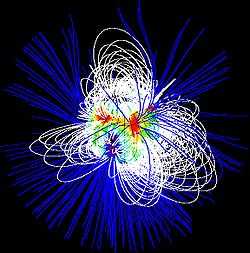
Summary
SU Aurigae is a T Tauri-type variable star in the constellation Auriga. It is located about 500 light-years (150 parsecs) away in the Taurus-Auriga Star Forming Region. Its apparent magnitude is 9.30, which is dim enough that it cannot be seen with the unaided eye.
 Diagram of SU Aurigae's magnetic field | |
| Observation data Epoch J2000 Equinox J2000 | |
|---|---|
| Constellation | Auriga |
| Right ascension | 04h 55m 59.38527s[1] |
| Declination | +30° 34′ 01.5190″[1] |
| Apparent magnitude (V) | 9.30[2] |
| Characteristics | |
| Spectral type | G2IIIne[2] |
| B−V color index | +0.74[3] |
| Variable type | T Tauri |
| Astrometry | |
| Radial velocity (Rv) | 23.20[4] km/s |
| Proper motion (μ) | RA: 1.18[1] mas/yr Dec.: -22.24[1] mas/yr |
| Parallax (π) | 6.85 ± 2.23 mas[1] |
| Distance | approx. 500 ly (approx. 150 pc) |
| Absolute magnitude (MV) | +2.83[3] |
| Details[3] | |
| Mass | 2.0±0.1 M☉ |
| Radius | 2.61+0.20 −0.23 R☉ |
| Luminosity | 6.3±1.6 L☉ |
| Surface gravity (log g) | 3.91+0.07 −0.10 cgs |
| Temperature | 5550±100 K |
| Rotation | 1.76+0.29 −0.33 |
| Rotational velocity (v sin i) | 66.2 km/s |
| Age | 4 Myr |
| Other designations | |
| Database references | |
| SIMBAD | data |
SU Aurigae's spectral type of G2IIIne means that it is a G-type star with an effective temperature similar to the Sun. The III in the spectral type refers to its luminosity, which is much higher than normal G-type main sequence stars and would put it in the giant star class.[5] However, it is only about 4 million years old, which is relatively young for a star - young protostars like SU Aurigae are luminous because they are larger, not condensing into a normal size until they are older.[6]

SU Aurigae is known to have a circumstellar protoplanetary disk surrounding it, which is typical of many T Tauri stars.[6] SU Aurigae's disk has a high inclination of 62° and is nearly perpendicular to the plane of sky, so orbiting protoplanets or comets may be the cause of why there are drops in the amount of light detected.[3] SU Aurigae's proper motion and distance is similar to AB Aurigae,[1] a better known pre-main-sequence star, meaning that the two may form a very wide binary system;[5] if not, they are still in the same star association.
References edit
- ^ a b c d e f van Leeuwen, F. (2007). "Validation of the new Hipparcos reduction". Astronomy and Astrophysics. 474 (2): 653–664. arXiv:0708.1752. Bibcode:2007A&A...474..653V. doi:10.1051/0004-6361:20078357. S2CID 18759600.
- ^ a b "SU Aur". SIMBAD. Centre de données astronomiques de Strasbourg. Retrieved 17 January 2016.
- ^ a b c d DeWarf, L. E.; Sepinsky, J. F.; Guinan, E. F.; Ribas, I.; Nadalin, I. (2003). "Intrinsic Properties of the Young Stellar Object SU Aurigae". The Astrophysical Journal. 590 (1): 357–367. Bibcode:2003ApJ...590..357D. CiteSeerX 10.1.1.508.2455. doi:10.1086/374979. S2CID 122600915.
- ^ Gontcharov, G. A. (2006). "Pulkovo Compilation of Radial Velocities for 35 495 Hipparcos stars in a common system". Astronomy Letters. 32 (11): 759–771. arXiv:1606.08053. Bibcode:2006AstL...32..759G. doi:10.1134/S1063773706110065. S2CID 119231169.
- ^ a b "AB Aurigae - Jim Kaler". 4 January 2013. Retrieved 17 January 2017.
- ^ a b "Encyclopedia of Science: T Tauri star". Archived from the original on 27 January 2021. Retrieved 17 January 2017.
- ^ Grankin, K. N.; Shenavrin, V. I.; Irsmambetova, T. R.; Petrov, P. P. (September 2018). "SU Aur: A deep fading event in Visible and near-infrared bands". Information Bulletin on Variable Stars. 6253 (1): 1. arXiv:1809.04466. Bibcode:2018IBVS.6253....1G. doi:10.22444/IBVS.6253.
- ^ Cody, Ann Marie; Tayar, Jamie; Hillenbrand, Lynne A.; Matthews, Jaymie M.; Kallinger, Thomas (March 2013). "Precise High-cadence Time Series Observations of Five Variable Young Stars in Auriga with MOST". The Astronomical Journal. 145 (3): 79. arXiv:1302.0018. Bibcode:2013AJ....145...79C. doi:10.1088/0004-6256/145/3/79. S2CID 1261183. Retrieved 1 November 2021.


